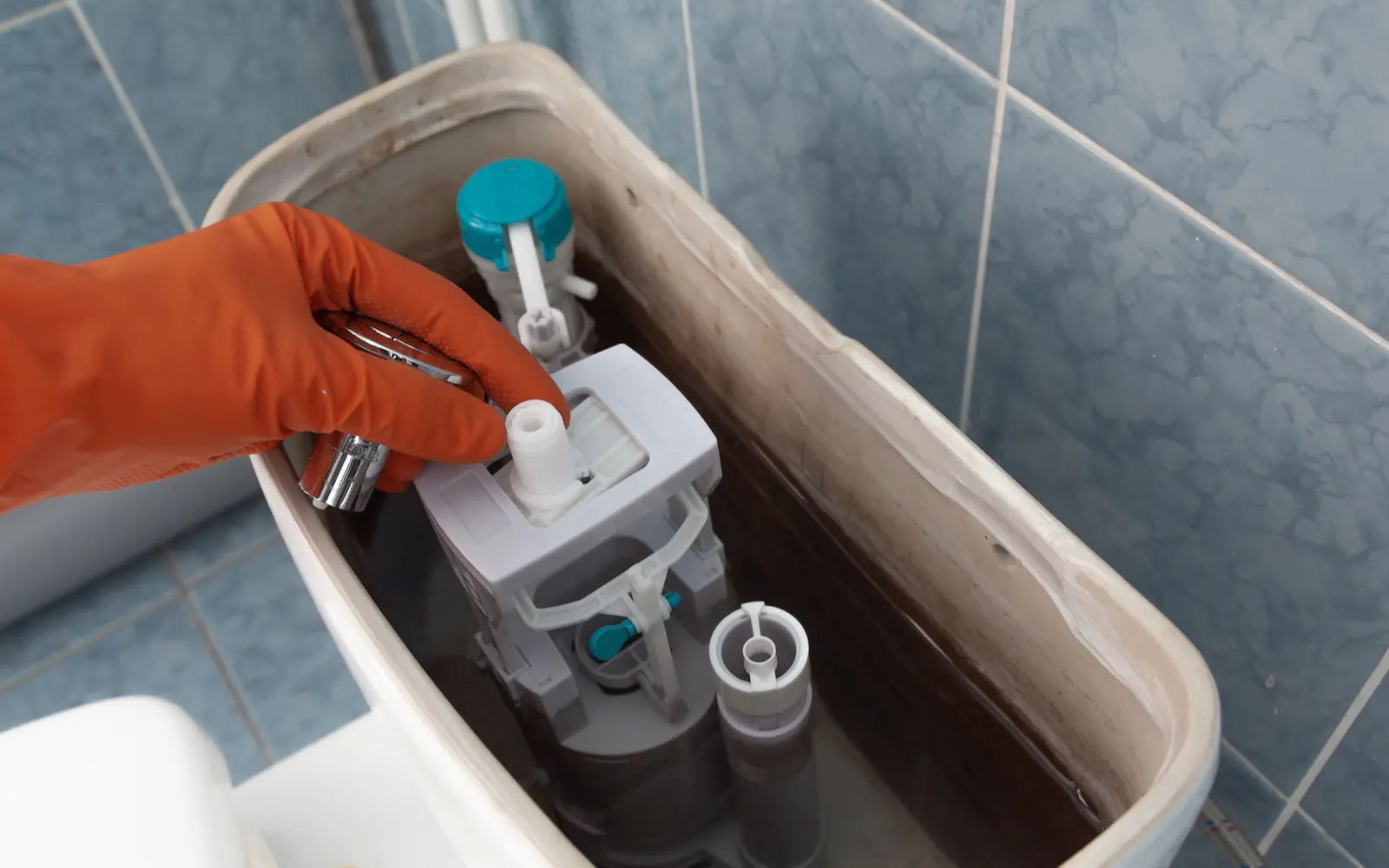Toilet tank parts are essential to the operation of a toilet. Let’s take a look at everything that makes your toilet tank work.
Most toilet tanks have an overflow pipe connecting to a galvanized steel ball valve with an integral check valve on the discharge side.
There’s also usually a water supply line connected to an inlet valve, usually brass or stainless steel, with a lever handle to control it from outside the tank.
These components are all hidden inside the tank, but understanding how they work can help you troubleshoot problems more easily if something goes wrong.
The 11 Main Toilet Tank Parts
The essential parts of a toilet tank include, but aren’t limited to, the bowl, flush valve, and flapper.
Your toilet can’t work without them. But there are a few more to know, including all of the ones below.
1. The Bowl
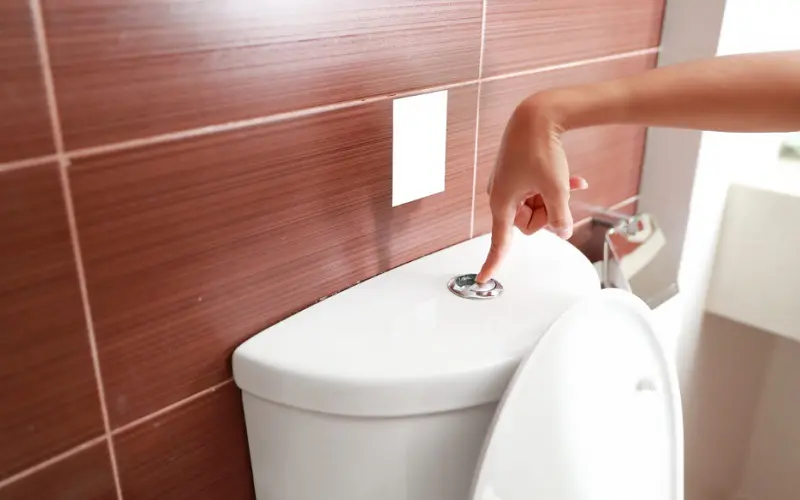
feeling lucky/Shutterstock
The bowl is the part of the toilet that holds the water before it’s flushed. It also has a top rim and bottom rim, as well as a flapper valve that regulates water flow.
The bowl parts may be metal, but their most common material is plastic or porcelain (pottery).
The bowl connects to a trapway, which opens when you flush the toilet. The opening allows water to enter the tank and drain out through another drain on your bathroom floor.
2. Flush Valve
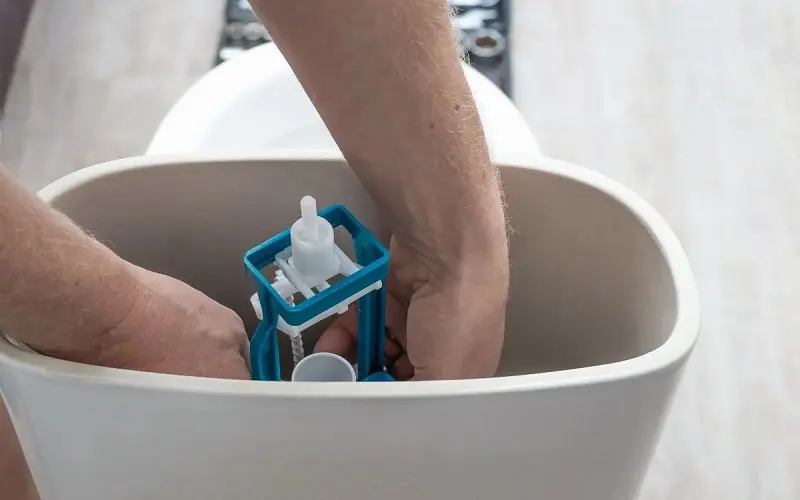
Natalia Kokhanova/Shutterstock
The flush valve is where the water supply line connects to the toilet and is what allows the tank to refill. The parts inside the flush valve are what trigger the refilling process.
The flush valve piston moves up and down to control the water coming into the bowl. The piston connects to a ball that floats in the water in the flush tank. The ball rises and falls as the water level inside the flush tank changes.
When the water level in the flush tank gets too low, the ball drops, opening the valve and letting water flow into the bowl. When the water in the flush tank rises high enough, the ball floats up, closing a valve to stop the water from flowing into the bowl
3. Ballcock Valve/Ball Float Valve
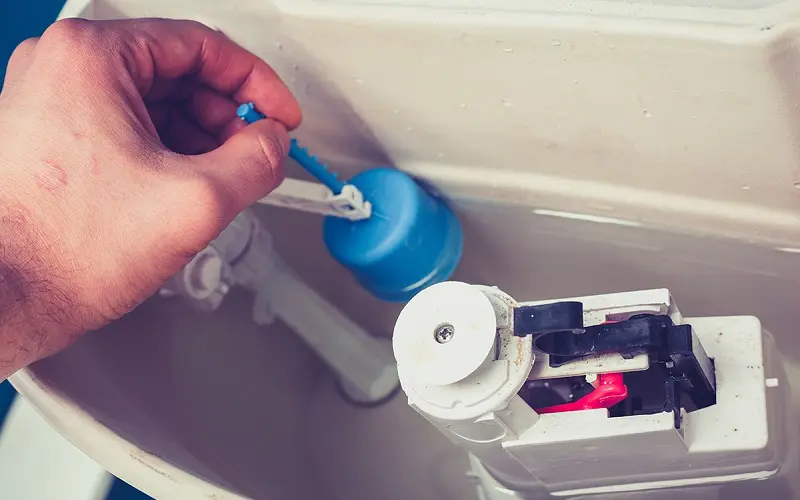
Lolostock/Shutterstock
The ballcock valve controls the flow of water into the tank and is what allows the toilet to flush. The ballcock valve sits at the top of the tank, operated by a handle connected to a lever. The lever controls the float ball.
4. Tank Lever
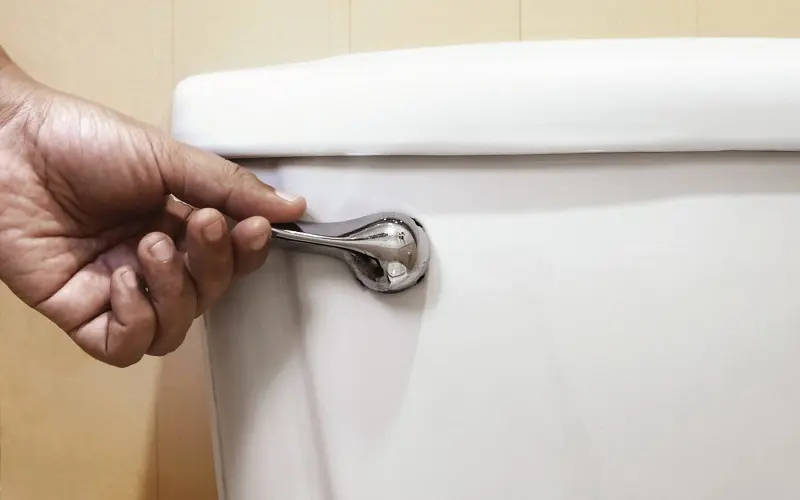
winnond/Shutterstock
The lever attached to the flush handle controls the water level in the tank. As the lever rises, it opens a valve, letting water from the toilet bowl into the tank.
When the lever lowers, the valve closes, stopping water from the tank from flowing into the bowl.
Water flows from the tank and bowl when the lever lowers to the middle position. You can adjust the lever to control the water level in the toilet tank.
5. Supply Lines
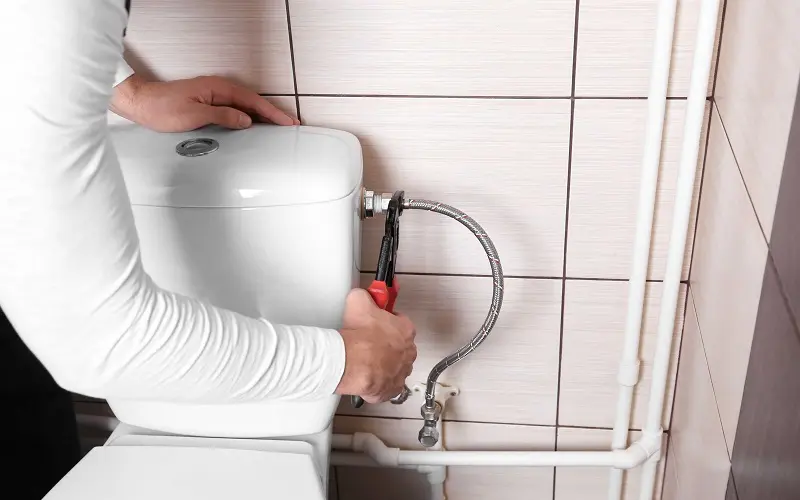
Africa Studio/Shutterstock
Finally, there are the supply lines. These are the pipes that bring fresh water into the toilet tank. It’s essential to ensure that these lines aren’t leaking, because leaks can lead to problems with your fill valve.
6. The Fill Valve
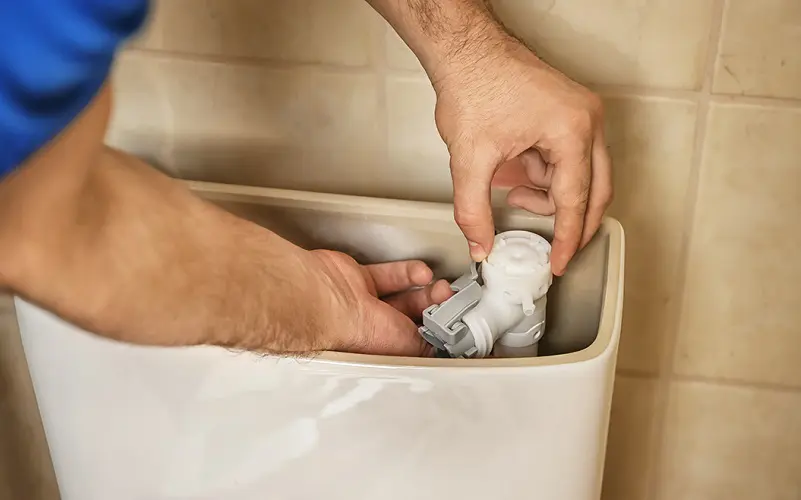
New Africa/Shutterstock
One of the critical toilet tank parts is the fill valve. This component controls how much water goes into the tank.
It’s crucial to ensure that this valve is correctly adjusted because too much or too little water can cause problems with your toilet.
7. The Flapper
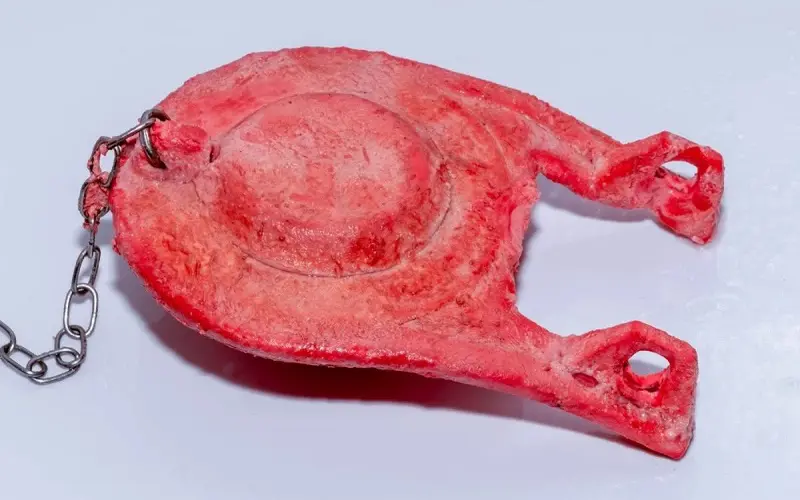
samray/Shutterstock
The flapper is a rubber seal that covers the flush valve. When you flush the toilet, the flapper lifts briefly to allow water to flow before falling back into place.
If the flapper has damage, it may not seal properly, causing water to leak out of the tank and resulting in a weak flush.
8. Locknuts, Bolts, and Washers
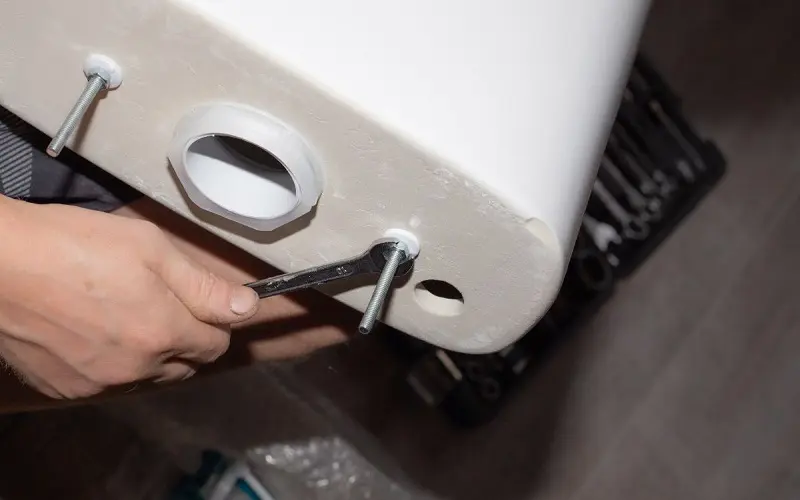
Natalia Kokhanova/Shutterstock
These parts serve to secure the toilet bowl to the base of the round, porcelain portion of the toilet. The bolts are attached to the base and bowl, holding them together.
Locknuts help to ensure the bolts are snug. If the toilet bowl is loose on the base, water can seep under it and cause damage to the floor. A loose bowl can also cause the toilet to wobble.
9. Toilet Tank Lid
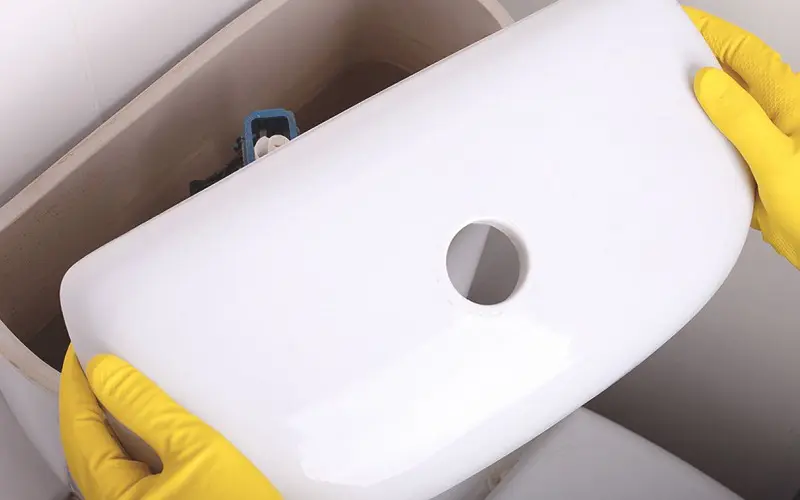
Stanislaw Mikulski/Shutterstock
The toilet tank lid covers the tank and keeps the water in. The lid provides a place for handle attachment so that you can use it to flush the toilet.
The lid on the toilet tank keeps germs and odors trapped inside. The lid has a rubber seal that keeps water inside the tank. The lid also has a handle that makes it convenient to lift open the tank and clean inside the toilet
10. Overflow Pipe
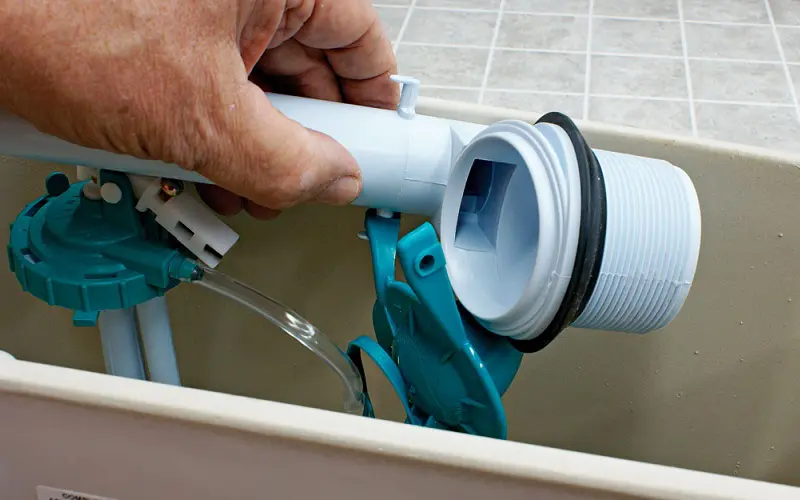
Image/finehomebuilding.com
Another optional part of a toilet tank is the overflow pipe. This pipe helps to prevent overflows by allowing water to escape from the tank if it begins to fill up too much.
A toilet without an overflow pipe may work as expected but is more likely to overflow, so it’s important to have one installed when installing a new toilet.
11. Leak Sentry Device

Image/Amazon.com
Connected to the float valve is a small metal lever called a “leak sentry device” (LSD). This device is usually just one small metal piece on top of the tank.
It keeps pressure from building up behind it when you flush at high volumes. Otherwise, if you flushed too much water at once, it could cause leaks around the base area where it sits on top of your toilet’s drain pipe.
Diagnosing and Repairing Toilet Tank Parts
Perhaps you’ve had the experience of flushing the toilet and seeing water gush from beneath the tank. Or maybe you’ve noticed that the toilet tank fills up much faster than it should, or not as fast as it should.
These are just a few of the many things that can go wrong with toilet tanks.
But even if you aren’t experiencing any obvious problems, rest assured that there could be something wrong with your toilet tank.
Let’s walk you through diagnosing common toilet tank problems and repairs for all major types of toilet tank parts.
Leaky Toilet Tank
When you have a leaky toilet tank, you’ll likely hear a dripping sound coming from the tank. This dripping sound will be louder if the toilet tank is upstairs or outside the bathroom.
There are also other ways to tell if your toilet tank is leaking:
- If the water level in the toilet tank is significantly lower than normal,
- If your water bill is higher than normal,
- If your toilet takes longer than usual to flush,
- If your toilet bowl has a dry ring around it when you wake up,
You can repair most leaking toilet tanks by replacing the flapper or flushing mechanism. If those toilet tank parts are working fine, the leak will likely come from the tank itself. Try checking and replacing the gaskets.
Flushing Problems
If your toilet doesn’t seem to be flushing as well as it used to, it could be due to a clog or a partial clog. It could also be due to a faulty flush valve, flush mechanism, or flush ball.
Other symptoms of the problem include:
- The toilet bowl water level is significantly lower than normal
- Toilet tank water level rise much faster than normal
- The bowl water level never rises above a certain level
- The tank never appears to be empty
- The toilet bowl water is extremely murky or dirty
If you suspect that you might have a clog in your toilet, the first thing to do is pour a gallon of water into the toilet bowl. If the water goes down without any problems, you may have a faulty flush valve.
If the toilet bowl water level rises and almost reaches the top of the bowl, you may have a faulty flush ball. These parts of a toilet tank may need replacing for your toilet tank to work great again.
Overflowing Tank
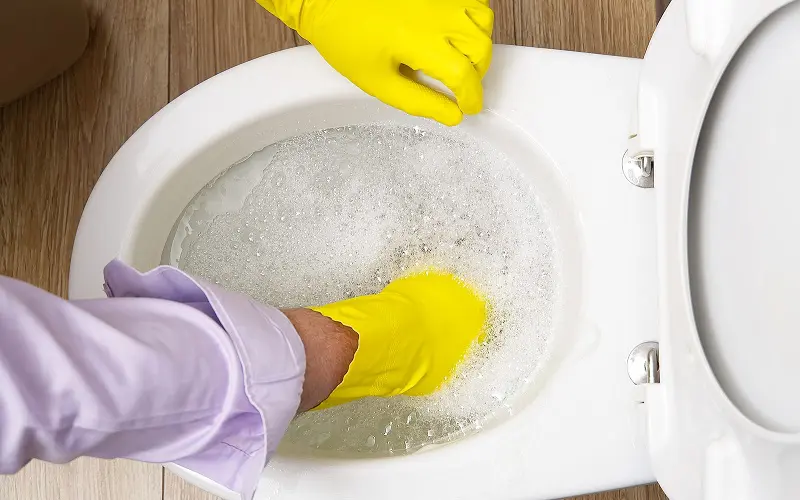
InFocus.ee/Shutterstock
If your toilet is overflowing, the cause could be a clog, improper float ball adjustment, a broken float ball, or a broken flush valve. The easiest way to determine the problem is to clean the toilet bowl.
The next thing to do is check and see if the float ball has the proper adjustment. If the float ball sits too close to the water level, it’ll cause the toilet to overflow.
If the float ball breaks, you can purchase a new one at your local hardware store. If you have a broken flush valve, you can buy a new one at your local hardware store. Here are other ways to tell if your toilet is overflowing:
Broken Float Ball
If your toilet tank is overflowing, there may be a problem with your float ball or float valve. The float ball or float valve is responsible for letting the toilet tank know when it’s full. If the float ball or float valve breaks, it won’t be able to let the toilet tank know when it needs emptying.
If your toilet tank is overflowing and you’ve checked the flush valve and determined that it isn’t broken, the next thing to check would be the float ball. If your float ball breaks, you must replace it with a new one.
My Toilet Won’t Flush
Several problems can be the cause of a toilet that won’t flush. The first step in diagnosing the problem is determining whether it’s a flushing or filling problem. To find out, try flushing the toilet with the lid down.
You’ll have to fix a blocking or broken fill valve if it doesn’t fill with water.
If it does fill but won’t flush, you’ll have to check for a clogged drain or a problem with the tank lever.
Frequently Asked Questions
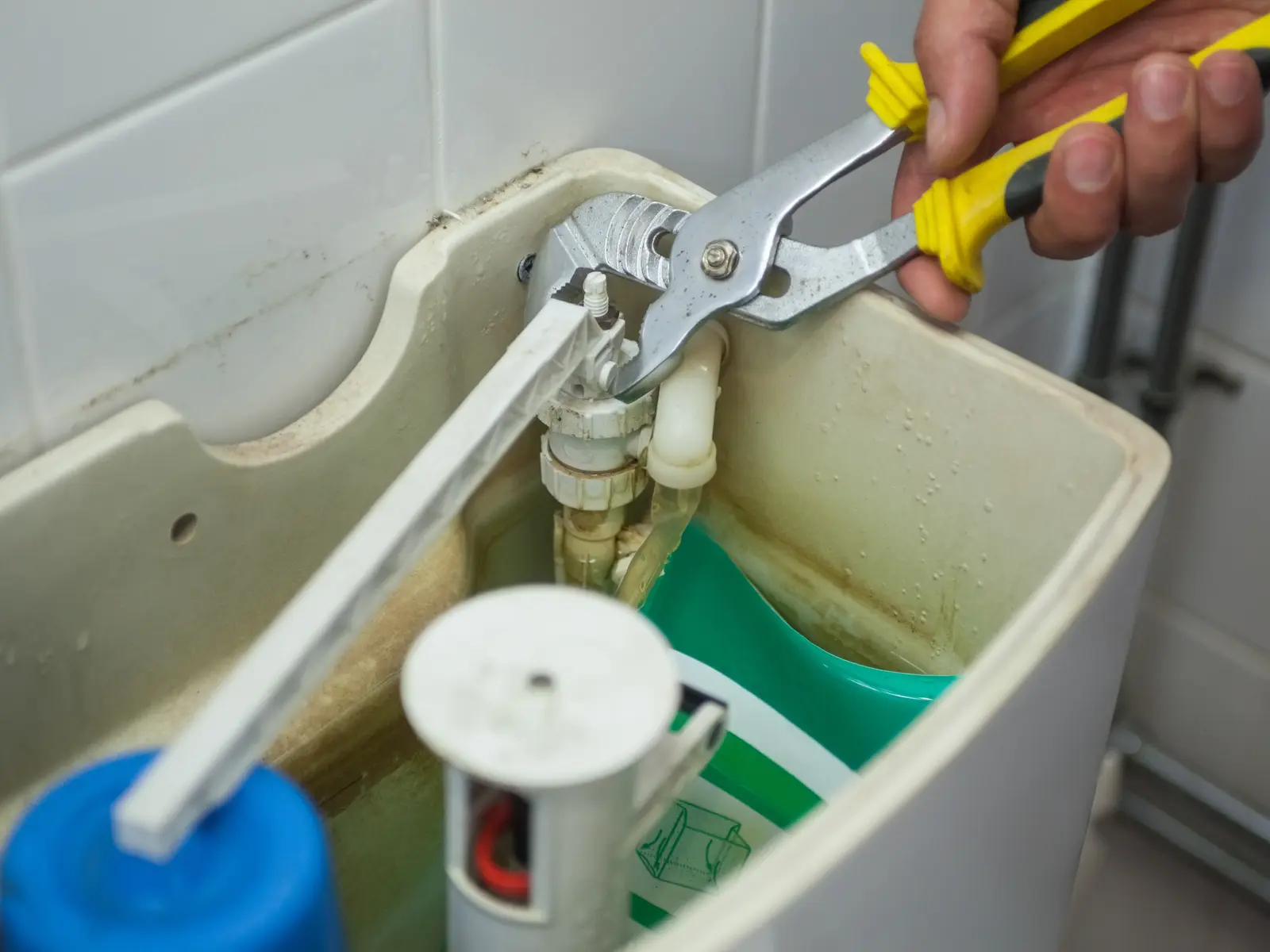
Wavebreakmedia/Shutterstock
Here are some of the most common questions about toilet tank parts:
How do I identify my toilet parts?
Most of the toilets have model numbers in different places. You can look up that number in the manual and identify the name of the part.
How often do you have to replace toilet parts?
It depends on the part you are replacing. The fill valve tends to last at least four years, while the flush valve may last up to seven. You can expect to replace the parts every few years while keeping the main bowl.
Can you replace the tank only?
Absolutely, you can replace the tank by itself. You just need to make sure the piece you buy matches your toilet.
What is the critical level valve in a toilet tank?
One reason toilets can be so efficient at using water is a device called the critical level toilet fill valve. When the tank becomes full of water, this valve will close and prevent the tank from filling beyond capacity.
The tank then empties its water into the toilet bowl as you sit on it. As the water goes down, the valve opens again to allow water flow into the toilet.
How does a toilet tank mechanism work?
The tank contains a ball or float, and when the water level rises, the ball or float rises, too. The float connects to a mechanism that causes the flush valve to open, and water flows into the toilet bowl.
When the water level falls, the float drops, too. The falling float allows a ball valve to close, stopping the flow. The tank must refill with water to flush again.
Keep Your Toilet Tank Running Smoothly
By understanding the anatomy of your toilet tank, you can troubleshoot any issues you may be having.
From the flush valve to the fill valve, parts of a toilet tank play an essential role in the proper functioning of your toilet.
So next time something goes wrong, don’t panic; look at this guide and figure out which part needs replacement or repair. You’ll be back to having a functional toilet in no time!

